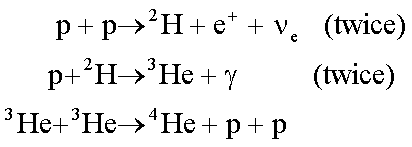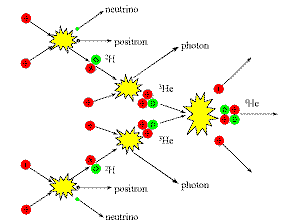

|
Astronomy 162:
Introduction to Stars, Galaxies, & the Universe
Prof. Richard Pogge, MTWThF 9:30
|
Lecture 12: As Long as the Sun Shines
Readings: Ch 18, section 18-1, 18-1, & 18-4
- Stars shine because they are hot.
- Need an energy source to stay hot.
- Kelvin-Helmholtz Mechanism
- Energy from gravitational contraction
- Doesn't work in the Sun now.
- Nuclear Fusion Energy
- Energy from fusion of 4 Hydrogen nuclei into 1 Helium nucleus
- Proton-Proton nuclear reaction chain
Why do stars shine?
Stars shine because they are hot.
- emit thermal (~blackbody) radiation
- heat "leaks" out of their photospheres.
Luminosity = rate of energy loss.
To stay hot, stars must make up for this lost energy,
otherwise they would cool and eventually fade out.
Case Study: The Sun
Question: How long can the Sun shine?
To answer this, we need to measure two numbers:
- How much internal heat is there in the Sun?
- How fast is this heat lost as sunlight (Luminosity = Energy/second)?
The "shining" lifetime of the Sun is just the ratio
of these two numbers:

Sources of Energy
In the early 19th Century, two energy sources were known:
Chemical Energy:
- Burning of oil or wood by oxidation
- Chemical explosives
Gravitational Energy:
- Water running downhill to power a mill.
- Heat from meteorite impacts
The Age Crisis: Part I
Both chemical and meteorite energy sources have serious problems:
- The most powerful chemical reactions known could only keep the Sun
shining for a few thousand years.
- Meteor impacts could work for at most ~1 Million Years.
The problem was that during the 1800s, Geologists had found that the
Earth had to be at least 10s to 100s of Millions of years old.
This leads to a logical inconsistency:
- How could the Earth be older than the Sun?
Energy source proposed by physicists
Kelvin[12.1] and
von Helmholtz[12.2]
in the mid-1800s:
Start with the Sun in
Hydrostatic Equilibrium
- Internal Pressure balances Gravity
Luminosity radiates away some of the Sun's internal heat:
- Causes the Sun to cool at little bit
The cooler Sun has a lower internal pressure:
- Lower pressure means Gravity gets the upper hand
- Causes the Sun to contract a little bit
Gravitational Contraction compresses the Sun:
- Increases its internal heat
- The pressure increases, restoring hydrostatic equilibrium
The Sun, slightly smaller, starts the cycle again.
The Age Crisis: Part II
Late 1800s:
- Helmholtz estimated that the Sun could shine for a little over
20 Million years via the Kelvin-Helmholtz
Mechanism. This corroborated estimates made by Kelvin
of the age of the Earth[12.3]
- Geologists around this same time had shown that the Earth was at
least 2 Billion years old.
Kelvin and Helmholtz would say: The Geologists are wrong.
Nature Says: Helmholtz and Kelvin are wrong. There is new
physics Kelvin doesn't know about...
Nuclear Energy
1896: Röntgen and Becquerel discover radioactivity.
1905: Einstein demonstrates that Mass and Energy are equivalent:
E=mc2
1920s: Eddington noted that 4 protons have 0.7% more mass than 1
Helium nucleus (2p+2n).
If 4 protons fuse into 1 Helium nucleus, the remaining 0.7% of the mass
leftover would have to be converted into energy.
Fusion Energy
Fuse 1 gram of Hydrogen into 0.993 grams of Helium.
Leftover 0.007 grams converted into energy:
E = mc2 = 6.3x1018 ergs
Enough energy to lift about 64,000 Tons of rock to a height of 1 km.
Hydrogen Fusion
- Question:
- How do you fuse 4 1H (p) into a 4He (2p+2n)?
- Issues:
- (1) Four protons colliding at once is unlikely.
- (2) Must turn 2 of the protons into neutrons.
- (3) Must be hot: >10 Million K to get protons close enough
to fuse together.
Proton-Proton Chain
The primary way that you can fuse 4 H into 1 He in the Sun is via a
3-step fusion reaction called the Proton-Proton Chain.
[12.4]

Proton-Proton Chain Schematic:

[Click on image to view full-size version (18Kb)]
The Bottom Line:
Fuse four (4) protons (1H) into one Helium (4He)
nucleus.
This reaction produces the following important by-products:
- 2 photons (energy in the form of Gamma-rays)
- 2 positrons (positive electrons)
- 2 neutrinos that leave the Sun carrying off more energy
Is this enough energy to do the job?
The Age Crisis: Averted
Luminosity of the Sun is ~4x1033 erg/sec
- Must fuse ~600 Million Tons of H into He every second.
- ~4 Million tons converted to energy per second.
- Sun contains ~1021 Million Tons of Hydrogen
- Only the inner 10% of the Sun is hot enough for fusion to occur.
Whenn all these factors are taken into account, we find:
Fusion Lifetime is ~10 Billion Years.
Modern estimates from radioactive dating give an age of the Earth of
4.6 Billion years. The Sun can potentially shine for about twice that,
averting the age crisis.
Test: Solar Neutrinos
- Question:
- How do we know that fusion is occurring in the core of the Sun?
- Answer:
- Look for the neutrinos created by the nuclear fusion reactions.
What are Neutrinos?
Neutrinos are weakly interacting neutral subatomic particles:
- Massless (or very nearly so)
- Travel at (or very near) the speed of light.
- Interact with matter via the weak nuclear force.
- Can pass through a block of lead 1 parsec thick!
The neutrinos created by nuclear fusion in the Sun's core should
simply stream out of the Sun at or near the speed of light.
Solar Neutrinos: Observed!
Detection of neutrinos is very difficult:
- Need massive amounts of detector materials (Gallium, Heavy Water, etc.)
- Must work underground to shield out other cosmic radiation
- Results:
- We have experimentally detected neutrinos from nuclear fusion in the
Sun with the expected energies.
The solar neutrino experiments confirm that the source of power in
the Sun (and by extension, other stars) in nuclear fusion.
The Solar Neutrino Problem
Of course, this not quite the whole story.
In the mid-1960s when the first solar neutrino experiments were
getting going, the goal of those experiments was to confirm that nuclear
fusion was the power source of the Sun by detecting the neutrinos.
So far so good, but a surprise of those experiments was that while
they detected neutrinos of the energies expected, they did not detect
enough of them.
This observation was quickly dubbed the "Solar Neutrino Problem".
It has become clear from the latest round of solar neutrino
experiments that we have essentially solved the Solar Neutrino Problem.
However, not by any particularly new understanding about the Sun, but by
the discovery of a fundamental new property of subatomic particles!
The details are subtle, but it is a great story about how sometimes
when scientists set out to answer a well-defined question they are lead
instead to a surprising new result that nobody ever even dreamed of.
Return to [
Unit 2 Index
|
Astronomy 162 Main Page
]
Updated: 2006 January 15
Copyright © Richard W. Pogge,
All Rights Reserved.




